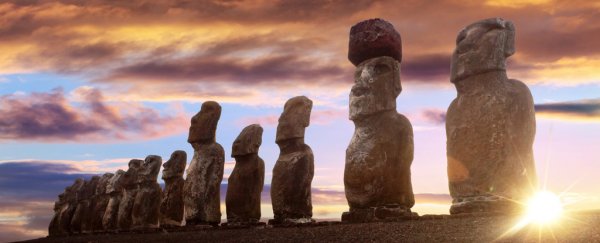The story of Rapa Nui or Easter Island and its earliest settlers may have to be rewritten after a new study of ancient remains on the island challenged the conventional thinking that the citizens recklessly destroyed their idyllic island environment.
It turns out that the Rapa Nui people may have had a more diverse diet and taken better care of their home than experts had originally thought, based on carbon and nitrogen isotope analysis of bone and plant samples dating back as far as 1400 AD.
When Europeans arrived on the island in 1722, they found a dwindling population, and the traditional narrative is that this ancient civilisation used up their resources too quickly over several centuries to be able to support large numbers of people.
Trees were chopped down at too fast a rate to clear land for farming, meaning fewer canoes could be built and less fishing could be done, and the resulting soil erosion hurt the farming on land too – that's the way the story's usually been told.
An international team of archaeologists now tell a different tale: they say human remains from the island show around half the protein in the diets of the ancient Rapa Nui people came from marine sources, much higher than previous estimates.
What's more, the food that was grown and eaten from the land appears to have come from enriched soils, so maybe the local people knew a bit more about farming than we'd given them credit for.
In other words the remains tell a story of a people able to adapt and survive in challenging environmental conditions, casting the standard ecocide narrative into doubt.
"The Rapa Nui people were, not surprisingly, smart about how they used their resources," says one of the team, anthropologist Carl Lipo from Binghamton University, New York.
"And all the misunderstanding comes from our preconceptions about what subsistence should look like, basically European farmers thinking, 'well, what should a farm look like?'"
"And it didn't look like what they thought, so they assumed something bad had happened, when in fact it was a perfectly smart thing to do. It continues to support the new narrative that we've been finding for the past ten years."
In recent years, Lipo and other archaeologists have been busy gathering evidence that doesn't fit with the idea of ecocide: radiocarbon dating suggests the land was being well cultivated until the Europeans arrived in the 18th century, while another hypothesis is that stowaway rats rather than aggressive farming were responsible for the reduction in tree coverage on Rapa Nui.
In fact there had been a suggestion that the Rapa Nui people started eating these rats for food – but that doesn't match up with the chemical composition the researchers saw in the bones dug up on the island.
"Our results point to concerted efforts to manipulate agricultural soils, and suggest the prehistoric Rapa Nui population had extensive knowledge of how to overcome poor soil fertility, improve environmental conditions, and create a sustainable food supply," conclude the researchers.
After all, an impoverished people would hardly have time to transport giant stone heads across the countryside – but then that's a whole other story.
The research has been published in the American Journal of Physical Anthropology.
